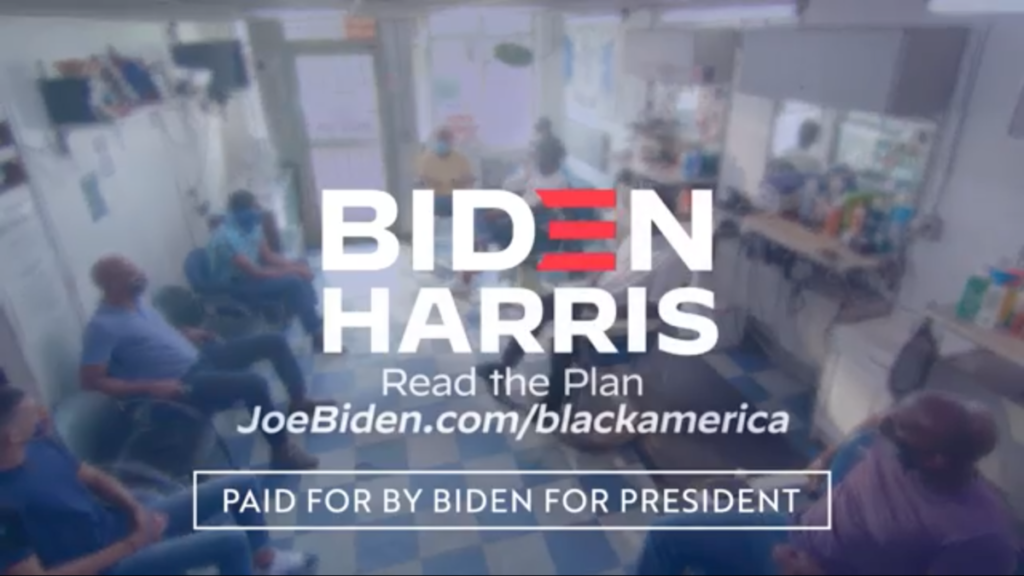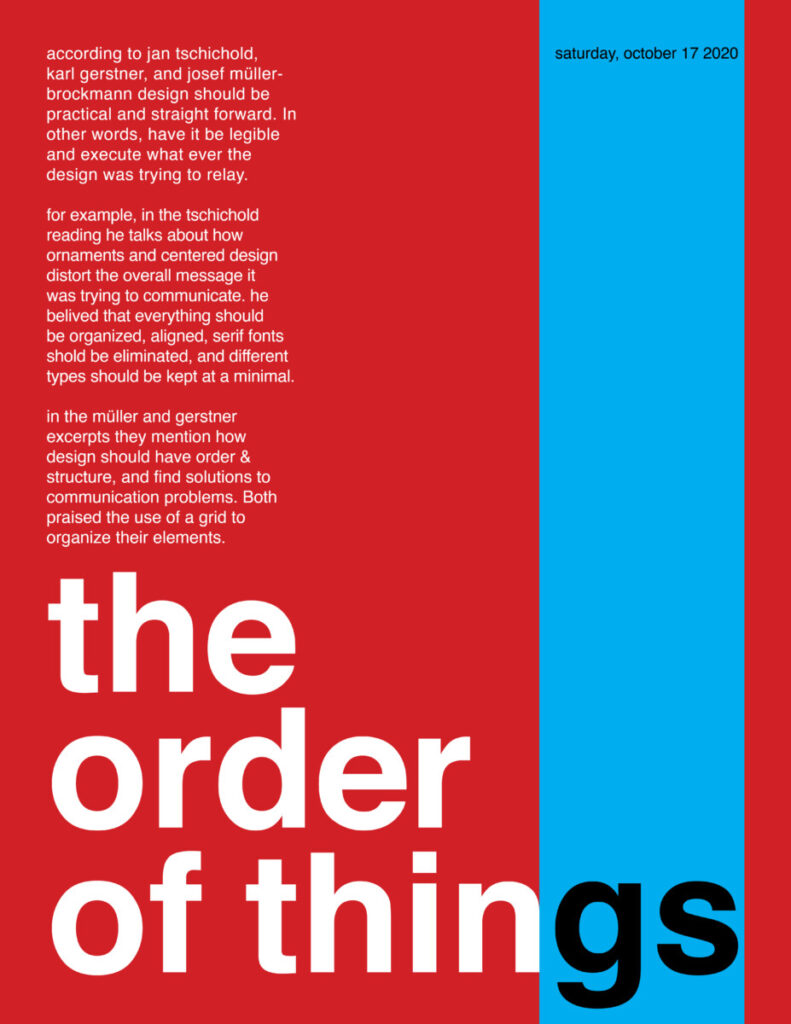Author: Christian (Page 1 of 2)

Staber, Margit. “Swiss Design Today.” Design Quarterly, no. 60, 1964, pp. 1–40. JSTOR, www.jstor.org/stable/4047306. Accessed 30 Nov. 2020.
Gaddy, James. “Altitude: Contemporary Swiss Graphic Design.” Print, vol. 61, no. 3, May 2007, p. 166. EBSCOhost, search.ebscohost.com/login.aspx?direct=true&db=a9h&AN=25070744&site=ehost-live&scope=site.
Mauderli, Laurence. “Positioning Swiss Design: The ‘Schweizerischer Werkbund’ and ‘L’Oeuvre’ at the Beginning of the Twentieth Century.” The Journal of the Decorative Arts Society 1850 – the Present, no. 25, 2001, pp. 25–37. JSTOR, www.jstor.org/stable/41809311. Accessed 30 Nov. 2020.
My take on “the concept of mainstream vs. underground relevant in contemporary design” is yes, he does believe that mainstream vs. underground is relevant in contemporary times. The way he describes mainstream stealing from underground culture is like a necessary evil, for example near the end of the Heller reading he states that underground designers who eventually join the mainstream at their own accords, do so because it is where they believe they can make the most impact on the medium and possibly even culture. He also believes the relationship between the two is almost parasitic in nature as mainstream steals from alternative culture, and sometimes lines begin to blur between the two.
An example of how parasitic mainstream can be comes from a YouTube channel called wisecrack where they discuss Banksy. They state how he is a street artist, an anticapitalist, and antiestablishment. Yet his art can be worth 100,000 or even millions of dollars and are often removed, as well as being sheltered from the elements. Another example of how mainstream leeches of something underground or not mainstream comes from the article Into the mainstream: Shifting authenticities in art where art of African, Aboriginal, Native American, others of non-European origins were once seen as primitive, but are now being shown in art shows and galleries.
While I haven’t made my final decision on what my final project will be, I am leaning towards a series of pride subway posters and I think it fits between an odd middle ground of mainstream and underground. I say that because when the fight for LGBT rights began, it wasn’t widely accepted but as time went people began to accept LGBT people or at least be more open minded on LGBT people. But when it comes to companies, these corporations are hesitant to show full on support. They might sprinkle some stuff here and there up until pride month comes around and they go full on support mode then go back to normal. They do it because it’s “cool” or “fashionable” like when companies go full on gay during pride month.
Heller, Steven. “Underground Mainstream.” Design Observer, 10 Apr. 2008, designobserver.com/feature/underground-mainstream/6737.
Price, Sally. “Into the Mainstream: Shifting Authenticities in Art.” American Ethnologist , vol. 34, no. 4, Nov. 2007, pp. 603–620.
Scherker, Amanda, director. Is BANKSY Deep or Dumb? – Wisecrack Edition, Youtube, 16 Mar. 2019, www.youtube.com/watch?v=sLGW4e1rqig.
To my understanding of Helen Armstrong’s “Introduction: Revisiting the Avant-Garde” she talks about how designers should have a sense of anonymity. Have the work be known but not the designer. This is something she states in the reading, “Design is a social activity. Rarely working alone or in private, designers respond to clients, audiences, publishers, institutions, and collaborators. While our work is exposed and highly visible, as individuals we often remain anonymous, our contribution to the texture of daily life existing below the threshold of public recognition.” Then she also states how in the early 20th century graphic design was built on anonymity and goes on to say that in the 50s and 60s “Swiss-style design solidified the anonymous working space of the designer inside a frame of objectivity.”
In the Bruno Munari reading, it seems like he is trying to say that art is mass & public affair and it should not be only accessible to the wealthy. He also mentions how artists should be humbled by getting down from their pedestal and design a butcher’s sign (if they know how to do it), and to cast off “the last rags of romanticism and become active as man among men.” He also mentions that an industrial designer is an engineer of sorts, but a designer in terms of graphics/art is a planner with an aesthetic sense, gives equal weight to each part. Which helps a designer play their role sufficiently as a communicator, someone who relays a message and informs the public.
One problem designers face is social responsibility, something that Armstrong talks about in her reading. She mentions how designers are being critical by using their designs. Instead of being complicit with corporations. Which dates back to when Rodchenko and Lissitzky where active. They were trying to bring about change, something revolutionary but when international style came into the scene, designers became part of corporate America. Then it began to change again as designers began to rebel, they began to critique society, they began to work with activists, they began to bring social changes. Basically, I think she is saying is that while yes we do need to make a living, there comes a point where are social and moral integrity does not get undermined by the corporations and clients we work for.
Language is a form of human communication that can be expressed verbally, be written down, or gestured. I think language is different from communication because it is a specific category (which can get even more specific) within the broader term of communication. It is like saying “all medicines are drugs, but not all drugs are medicines.” For example, we are able to communicate through imagery and symbols, which is a method that predates the concept of language we know today. In the past humankind has used hieroglyphs and pectorals to communicate with one another and today we use symbols on signs and designs like posters, and cards which are often paired with written language.
I believe that language is related to symbols and iconography because they are a precursor to contemporary language and that they can go hand-in-hand with one another. To illustrate, in the Saussure reading he mentions how an image of a tree has an associative bond with arbor, the latin word for tree, uniting a concept and sound-image (word) which creates a sign. Another example is when Saussure replaces concept and sound-image with “signified” (something that is expressed) and “signifier” (something that is used to point out another thing) which to me shows the close connection between imagery and language.
The relationship between imagery and language is also emphasized in the Language of Dreams section of the Lupton & Miller readings. An example they provided is airport-moji, a system in place of the Latin alphabet if it did not exist. It is represented with a chart divided in two categories, pictographs and ideograms. On the pictograph side they point out how pictographs can conjure up something literal and specific, like a key over a car can mean a car is dreaming about a key. While on the ideogram side, the symbols can represent a concept or idea (and something a bit broader) which is a bit more in line with the Saussure reading, except it is in reverse. For example, with the car and keys it can mean car key, parking, or “please lock your cars”, but it actually means car rental. In this case the car and keys is the “signifier” the interpretation as the “signified”, and its actual meaning as the “sign”.


This is an advertisement ad from Camel Snus, a tobacco company targeting the LGBT community. This ad shapes the company as an accepting and progressive company, but in reality it is pandering to the LGBT community to buy tobacco products. It is almost predatory and opportunistic, as they wear a veil of acceptance simply to increase sales. LGBT+ people are more likely to smoke compared to their heterosexual cisgender counterparts. http://www.trinketsandtrash.org/detail.php?item_number=213662

Here we have a commercial from the Biden campaign called Shop Talk Trust. It targets African-Americans, specifically Black men to vote. While I believe this commercial is well intentioned, encouraging Black men to vote and it is not following stereotypes, to some degree it is also pandering. At the end of the day this is politics and politicians have to pander to groups if they want this specific community’s vote. https://www.youtube.com/watch?v=f_N0-Fx2liU

This is a promo ad for a DC Comics event where the main heroes hand over the mantle to a younger generation. To me this paints as DC as a company that is trying to be more inclusive and diverse. You see several people of color like Jackson Hyde (Aquaman), the new Wonder Woman named Yara Flor, and some characters even have disabilities. Despite this being temporary as comics always return to the status quo, they are putting some effort like getting Black writers for Black characters. https://www.comicsbeat.com/dc-future-state-titles-creators/
I am actually having trouble understanding the reading. But I will try my best to give my interpretation of the excerpts of Marshall McLuhan’s book Understanding Media: The Extensions of Man.
To my understand in the first chapter, McLuhan seems to be talking how about how the “message” or “medium” of technology can help us accelerate our progression. For example he states that the railway system did not invent motion, transportation, wheels, roads, or movement, but instead made it easier to go from one location to another, expanding our reach. He also mentions how the medium drives the message. He uses light for an example, when electrical light was harnessed by people, we use it for brain surgery or light up a baseball game at night. He states that this underlines that “the medium is the message” because it is the medium that shapes and controls the scale and form of human association and action.”
As previously stated I am also having trouble understanding chapter 7 the Nemesis of Creativity of Understanding Media: The Extensions of Man. To me he seems to be talking about how does technology fit in human society and how it could change us for the worse and possibly for the better (probably not). Which in my opinion seems to supplement chapter one of the book. For example he mentions how artist are the only people that can avoid the “bully blow of new technology of any age.” I assume what he is trying to say is that artist are able to avoid how technology can change someone and society as a whole while being aware of what is happening as he refers artists as a “men of integral awareness.” Then he compares technology as something a kin to a disease, something invasive. That no one is immune to the advancement of technology. This to me, means the change that technology brings is inevitable and everyone will be affected by it, except for artists apparently.




Recent Comments